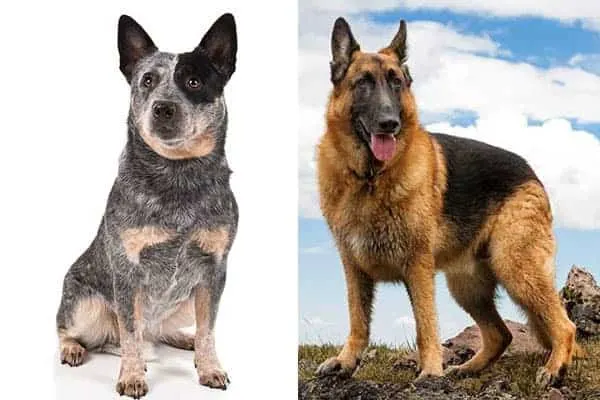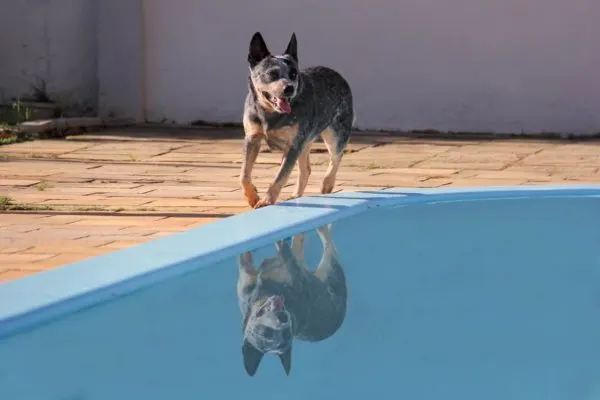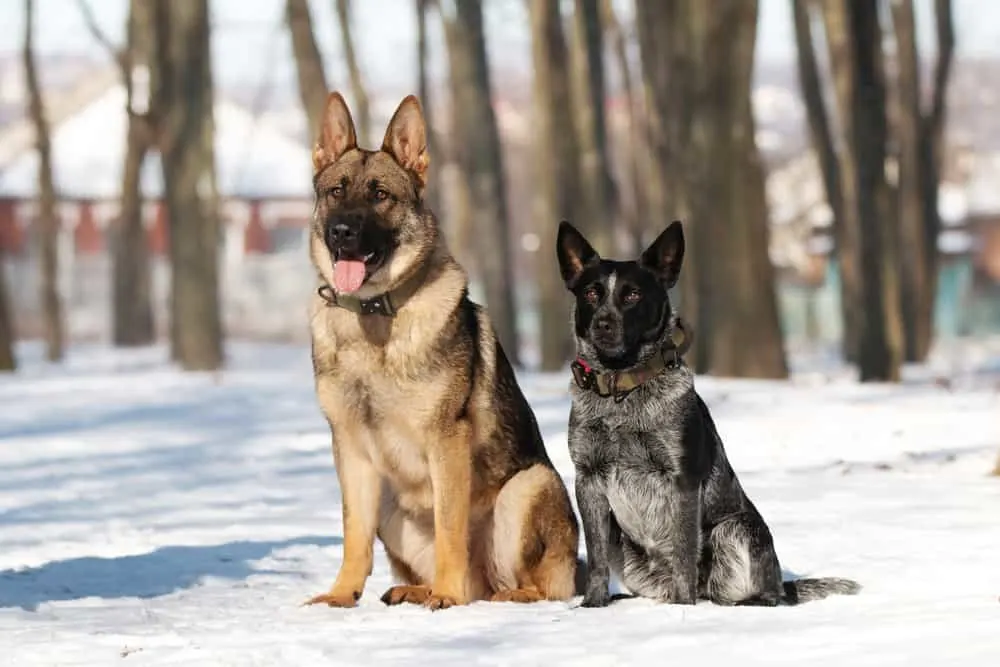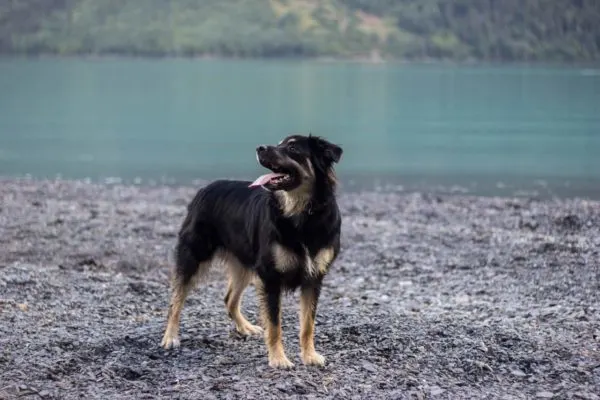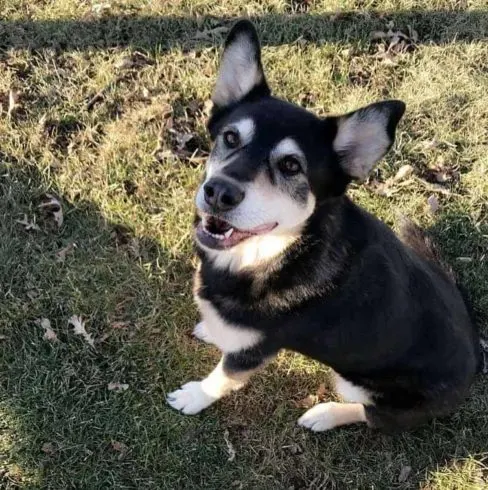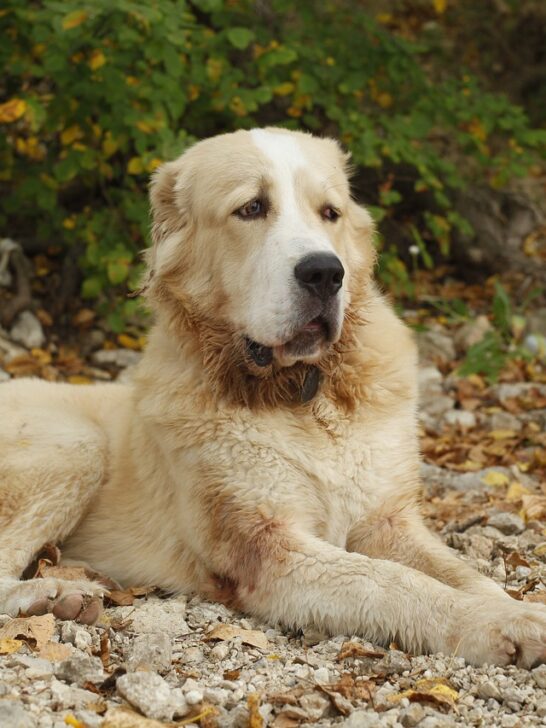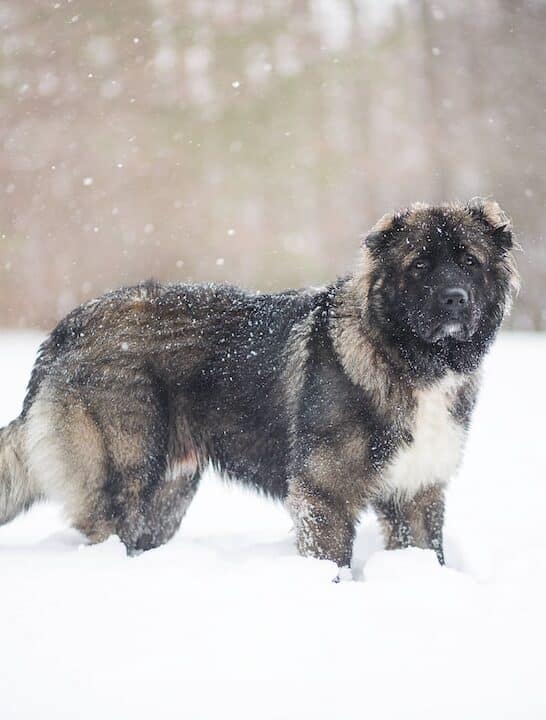German Shepherd Blue Heeler Mix: A High Energy Working Pup
The Blue Healer and German Shepherd mix is a relatively new breed developed about thirty years ago. It is a working dog breed and is intelligent and obedient.
The parents may be a German Shepherd and a Blue Heeler, or both may be a Blue Heeler German Shepherd mix. This hybrid breed has a double-layered, dark, thick working-dog coat, providing insulation and protection. They shed annually and year-round and do not need grooming.
They are trainable and thrive when socialized. Socialization reduces their tendency to be aggressive towards other dogs. They have a life expectancy of seven to sixteen years, and their hybrid creation reduces the risk of various health risks. They are about twenty inches tall and weigh sixty pounds.
Both the parent breeds of this dog are working dogs and are highly active. The German Shepherd was bred as a herding dog and was later bred as a show dog.
The Blue Heeler or Australian Cattle Dog was created when the Britishers who emigrated to Australia bred their Smithfield dogs with Australian wild dogs called dingos. It was named heeler because it tended to nip at the heels of the livestock and herd them.
German Shepherd dogs are notorious for having increased genetic (heritable) health issues over the past several years. These issues may be alleviated by adding genetic diversity to the gene pool and interbreeding.
German Shepherds are prone to dysplasia (hip, elbow), autoimmune thyroiditis, and cardiac issues, including congenital, degenerative myelopathy, temperament, and eye issues.
They also carry the potentiality of ailments like dysplasia (hip, elbow), patellar luxation (trick kneecap), and eye issues, including lens luxation and progressive retinal atrophy, in addition to cardiac problems, congenital deafness, and OCD/osteochondritis dissecans (hocks).
A healthy German Shepherd Blue Heeler puppy should have healthy joints, hearts, eyes, and immune systems and be a healthy dog overall.
This hybrid breed has a unique temperament, high prey drive, chase instincts, and high energy levels. They are impeccably loyal guard dogs and need at least two hours of intense activity per day. Although puppies should not be exposed to rigorous exercise too early, the closure of the soft growth plates at the top of each leg bone must be ensured by an X-ray through the veterinarian to ensure finishing growth.
One can identify a breeder’s specialization generation by looking at numeric clues labeled F1, F1b, F2, F3, F4, and so forth. The size of the Blue Heeler German Shepherd mix dog depends upon which parent it takes after.
German Shepherds are long and tall, while Blue Heelers are shorter and stockier. Usually, the German Shepherd Blue Heeler mix weighs between 35 and 90 pounds and measures 17 to 26 inches in length.
Their interbred offsprings are intelligent and respond effectively to positive reinforcement. They are protective and thrive on mental stimulation. One may call them family dogs, but it is preferable not to have toddlers or small kids around these dogs.
They are also not suitable for families with small pets like rabbits or hamsters since they have prey instincts and hunt smaller animals. Because they are working dogs, they take on leadership roles and try to be dominant among other dogs.
German Shepherd Blue Heeler Mix: Breed Combinations
A German Shepherd Blue Heeler mix is a dog breed that will normally have one purebred German Shepherd parent breed and one Blue Heeler parent breed.
A German Shepherd Blue Heeler dog can also have two German Shepherd Blue Heeler dog parents!
Which set of parents your mix has will influence what your GSD Blue Heeler puppy looks like, how your puppy acts, and what specific needs it’ll have.
Quick Facts
| Breed | Temperament | Coat | Training | Health | Suitability For Families | Size | Price |
|---|---|---|---|---|---|---|---|
| German Shepherd Blue Heeler mix | Highly intelligent, energetic, loyal, & protective. | Dark, thick, double layer coat that sheds seasonally and year-round. | Very trainable. Puppy socialization & training will be important. | Life expectancy: 7-16 years. Genetic diversity should reduce hereditary health risks. Needs an active lifestyle. | Can make great family guard dogs with proper training. | Weight: roughly 60 lbs. Height: around 20 inches tall. | $500 minimum |
Meet the Parent Dogs
The German Shepherd and the Blue Heeler (Australian Cattle Dog) are each iconic dog breeds in their own right.
Both have very distinctive looks and temperaments. They also share some important similarities that make crossing the two a good idea from a hybrid breeding perspective.
German Shepherd Dog
The German Shepherd is one of those dog breeds that needs no introduction – the “GSD” is just that popular.
As the American Kennel Club (AKC) explains, the German Shepherd breed was first envisioned by a retired German Cavalry officer named Captain Max Von Stephanitz.
The Captain had a very simple goal: he wanted to produce the perfect working dog.
Interestingly, the German Shepherd dog’s original role was herding livestock – not protecting people, which is what the GSD is best known for today.
Captain Von Stephanitz didn’t care what the dog looked like, as long as the new breed had the right working dog traits.
But over time, people started to care more about the look of the German Shepherd and two breed lines diverged.
Today, there are two distinct breed lines for the German Shepherd dog: the “show” or appearance-based line and the pure working dog line.
If you want your German Shepherd Blue Heeler mix dog to work, you may want to pick a hybrid puppy whose GSD dog parent comes from the working breed line.
Blue Heeler (Australian Cattle Dog)
The Australian Cattle dog is the formal breed name for the Blue Heeler dog. There are also Red Heeler dogs.
As the American Kennel Club (AKC) points out, the two dog lines are only distinguishable from each other by coat color.
The Australian Cattle dog’s history actually began in Britain with a breed known as the Smithfield dog.
When British ranchers emigrated to Australia, they bred their Smithfield dogs with wild Australian dogs called dingos resulting in the hybrid known as cattle dog.
These were the earliest Australian Cattle dogs. These new hybrids were also crossed with Scottish Highland Collies, Black and Tan Kelpies, and even the iconic Dalmatian.
This has given the Australian Cattle dog its signature blend of stellar working dog traits.
This interbreeding has also given the Australian Cattle Dog its unusual nickname of “blue heeler” or “red heeler”.
This comes from both the dog’s coat color and tendency to nip at the heels of livestock (or people) to herd them.
Health
A major topic surrounding today’s hybrid dog breeding programs is a concern about dog breed health.
German Shepherd dogs in particular have been plagued with an increase in genetic (heritable) health issues over the past several years.
Many point to modern breeding practices as a potential cause for the increase in serious health issues, some of which can be severely life-limiting or even fatal.
Breeding the “show” line of German Shepherds involves strict adherence to an appearance standard.
This may have promoted certain less desirable genes along with those that code for the desired appearance.
But whatever the cause, there is one thing canine biologists do know for sure:
Adding back genetic diversity to the GSD gene pool may be able to strengthen future generations of German Shepherds.
Unfortunately, there are only two viable ways to add back genetic diversity: find a new breed line of German Shepherds to cross-breed with, or opt for hybrid dog breeding.
In this case, the only viable option is hybrid breeding.
Blue Heelers also have a growing list of heritable health issues that can cause joint, heart, knee, eye, and other problems that can be life-limiting or fatal.
For the Australian Cattle Dog, hybrid dog breeding programs represent one possible way to increase genetic diversity and strengthen the health of future generations.
Let’s now take a closer look at the known health issues that can appear in each parent dog breed.
To do this, we’ll consult the Canine Health Information Center (CHIC) database.
Purebred breeders can participate by adding health records for their breeding stock (parent dogs) to increase knowledge of breed-based health issues.
German Shepherd health concerns
According to the CHIC database, all German Shepherd dogs that are going to be bred should be pre-screened for these known genetic health issues:
- Dysplasia (hip, elbow)
- Autoimmune thyroiditis
- Cardiac issues, including congenital
- Degenerative myelopathy
- Temperament issues
- Eye issues
Blue Heeler health concerns
According to the CHIC database, all Blue Heelers that are going to be bred should be pre-screened for these known heritable health issues:
- Dysplasia (hip, elbow)
- Patellar luxation (trick kneecap)
- Eye issues, including lens luxation and Progressive Retinal Atrophy
- Cardiac issues
- Congenital deafness
- OCD/Osteochondritis dissecans (hocks)
In reviewing the major genetic health issues each dog breed is known to carry, you can see how some of the health issues are quite similar for both breeds.
In particular, you’ll need to make sure the parent dogs of your German Shepherd Blue Heeler puppy have healthy joints, hearts, eyes, and immune systems and are healthy dog overall.
Any responsible breeder should be happy to share the results of all pre screening test results on both parent dogs.
Ideally, you should also take the time to meet and interact with both parent dogs before making a lifetime commitment to a new puppy.
Breed Characteristics
What can you expect when you decide to welcome a German Shepherd Blue Heeler mix dog into your life?
What will your new dog need from you? What type of personality and temperament can you expect?
How much exercise will your new puppy want and need? How about brushing and grooming needs?
Let’s find out!
German Shepherd Blue Heeler Mix weight and height
The German Shepherd dog can weigh 50 to 90 pounds and stand 22 to 26 inches tall (paw pads to shoulder tops).
The Blue Heeler can weigh 35 to 50 pounds and stand 17 to 20 inches tall.
Depending on what generation your hybrid puppy comes from, the potential weight range can be anywhere from 35 to 90 pounds, which is quite a wide range!
In terms of height, you’re looking at anywhere from 17 to 26 inches tall – again, quite a range.
If we look at averages without factoring in gender, the most likely outcome is a hybrid dog weighing around 60 pounds and standing around 20 inches tall.
German Shepherd Blue Heeler Mix temperament
The German Shepherd and the Blue Heeler have very distinct and unique temperaments.
The first thing to remember is that both of these dogs are true working dog breeds. Most working dog breeds have naturally high energy levels and love staying active.
Both make great family guard dogs, will be protective of their home and family, and will need mental as well as physical stimulation.
Both breeds are incredible canine athletes, who will easily escape if your yard isn’t dog proof!
A German Shepherd Blue Heeler mix puppy is going to crave athletic outlets and an active lifestyle.
Whether you involve your dog in canine athletics or put your pup to work, these dogs are born to work long hours with dedication and diligence.
In other words, a German Shepherd Blue Heeler mix dog won’t do well living a life of leisure.
While puppies sleep a lot, you need to be prepared to devote at least two hours per day to running, playing, and caring for your adult dog.
German Shepherd Blue Heeler Mix exercise and training
German Shepherds and Blue Heelers have been deliberately bred through generations to work hard, long hours every day of their adult lives.
The one caveat to keep in mind is that puppies must not be allowed to exercise too vigorously until they’ve finished growing.
The only way to know when your dog is finished growing is to have your veterinarian do X-rays of the long leg bones.
What your vet is looking for is the closure of the soft growth plates at the top of each leg bone.
This typically occurs at the age of 12 months or older. Once the growth plates have closed and hardened, your dog is done growing.
At this point, you can train for canine athletics, K-9 protection work, or herding.
There will no longer be the risk of damaging your dog’s musculoskeletal system, tissues, tendons, ligaments, or muscles.
With a highly intelligent dog like the German Shepherd Blue Heeler mix, only use positive reinforcement training methods like praise, treats, pats, and playtime.
These dogs will bore easily if training sessions become repetitive or drag on for too long.
For best results, add new skills to each training session and keep the sessions short, fun, and extremely positive.
German Shepherd Blue Heeler Mix shedding and grooming
Let’s now turn our attention to a topic that many prospective dog owners have questions about – grooming, shedding, and coat care.
The first thing dog owners absolutely need to know about both the German Shepherd and the Blue Heeler is that each dog has the classic working dog coat.
A working dog coat is a double layer coat that serves two purposes: protection and insulation.
The inner layer of a working dog’s coat is like a down jacket. It is soft, thick, and warm, and keeps the dog’s skin dry.
The outer layer of a working dog’s coat is like a protective parka. It’s longer and coarser, and is naturally water-repellent.
This outer coat layer protects the dog from bites, sunburns, windburns, and from being drenched in the rain.
The inner layer of the coat will “blow out” seasonally as the dog’s body adjusts to different temperatures.
This seasonal shed is called a “coat blow” for a reason – it looks like a snowstorm of dog hair!
Year-round, the working dog coat sheds lightly to replenish itself and keep all the guard (top) hairs functional.
So your German Shepherd Blue Heeler mix will definitely shed. The best way to control shedding is to do daily de-shedding and brushing.
Luckily, neither breed requires professional grooming so your hybrid puppy won’t either.
You can easily perform minor routine maintenance tasks like trimming the hair around the paw pads and cleaning your dog’s ears.
You won’t have to bathe very often unless your dog rolls in something stinky.
In fact, bathing too frequently can strip the outer layer of the coat of some of its water-repellant, protective properties, so you want to bathe sparingly.
Special Considerations For a German Shepherd Blue Heeler Mix Dog
You now know that the German Shepherd Blue Heeler mix dog is going to be smart, active, energetic, protective, playful, and eager to spend time with you.
If you have very young children in your home, you may want to wait until they’re older before bringing home a German Shepherd Blue Heeler.
This dog will have a tendency to nip at your heels to “herd” you. Young children, in particular, might find this upsetting or stressful.
Another thing to consider is if your family already has ‘vulnerable’ pets such as small mammals, rodents, birds, or reptiles.
The German Shepherd Blue Heeler may not be the best choice in this case.
These dogs are hunters with a strong prey drive and chase instinct – this may put your other pets in harm’s way.
Understanding Hybrid Breeding By Dog Generation
As Breeding Business explains, there are several different generations that a hybrid dog breeder can choose to focus on.
It’s easy to tell which generation a breeder specializes in by looking for numeric clues in the breeder’s description.
These clues are labeled F1, F1b, F2, F3, F4, and so forth. A breeder can specialize in multiple generations and may indicate the differences between litters on their website.
So let’s take a closer look at what each classification is referring to.
This can help you decide what generation of German Shepherd Blue Heeler mix puppy you would like to add to your family.
F1
An F1 generation hybrid breeder focuses on the earliest stage of hybrid dog breeding – crossing two different purebred dog breeds together to produce puppies.
F1 puppies would have one purebred German Shepherd dog parent and one purebred Blue Heeler dog parent.
The F1 generation is arguably the most interesting generation for dog breeders. It’s literally impossible to calculate in advance how each parent dog’s DNA will influence the puppies.
For example, one puppy in the litter may get the Blue Heeler parent dog’s signature coat markings and the German Shepherd dog parent’s height.
Another puppy in the very same litter may inherit just the opposite blend of traits.
Choosing to get your puppy from an F1 generation breeder is kind of like saying “surprise me!”
Alternatively, you can tell your breeder what traits you prefer and ask to be notified when a suitable puppy becomes available.
F1b
F1b generation dog breeding typically pairs one purebred dog parent (either a German Shepherd or a Blue Heeler in this case) with one hybrid dog parent (here, a German Shepherd Blue Heeler mix).
In dog breeding terminology, this is called “back-crossing.” It means choosing one parent dog from the current generation and one parent dog from the previous generation.
In this breeding stage, the breeder is refining for preferred traits, whether they be for appearance, temperament, or some combination thereof.
F2
F2 generation dog breeders have a different focus for their breeding programs – they’re cross-breeding two-hybrid dog parents.
With two parents who are each half German Shepherd – half Blue Heeler, there’ll be more uniformity among the puppies in each litter in terms of appearance and temperament.
As an example, if you need your dog to grow to a certain size, you would want to work with a breeder who focuses on F2 stage or later dog breeding.
F2b
The focus of an F2b breeding program is once again further refinement to the new hybrid breed through back-crossing.
F3, et al
With each later stage of a hybrid dog breeding program, the puppies grow more and more uniform in every way.
Except for certain “natural” dog breeds, this is how nearly all of today’s recognized, registered purebred dog breeds came to be.
For many of today’s purebred dog breeds, more than two other dog breeds were crossbred to develop the breeds.
Is a German Shepherd Blue Heeler Mix Dog the Right Dog for You?
For the right family or individual who wants to lead an active lifestyle with a dog by their side, this mixed breed dog may make a fabulous companion canine!
Frequently Asked Questions
How big will a German Shepherd Blue Heeler mix get?
The average German Shepherd Blue Heeler mix will reach a weight of 60 pounds, and a height of 20 inches. However, this doesn’t really give us an accurate picture of the potential size range.
In actuality, your dog could be significantly smaller, or much larger. It depends on what parent breed it takes after most.
Potentially, a German Shepherd Blue Heeler mix could be between 35 and 90 pounds, and 17 to 26 inches. The reason for this is the size differences between the parent breeds.
While the German Shepherd is long and tall, the Blue Heeler is shorter and stockier. As we can’t know exactly who the puppy will take after, we’re left with more possibilities.
A fully grown German Shepherd Blue Heeler mix can be quite a big dog. On average, it will be smaller than a purebred German Shepherd.
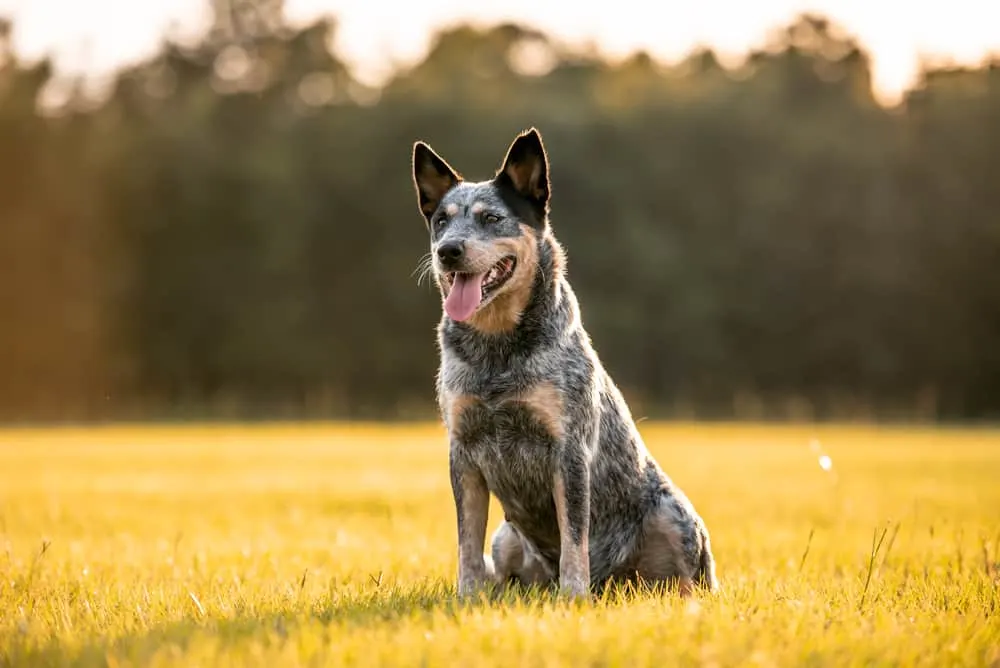
Are Blue Heeler German Shepherd mix good dogs?
The Blue Heeler German Shepherd mix is bred from working dogs, creating a puppy that’s intelligent and full of energy. They’re good dogs, and can be trained well.
As an intelligent breed, they respond best to positive reinforcement. However, they can also get bored easily. When you want to train your dog, you need to take care to keep the sessions energetic.
Give lots of positive feedback, keep the training short, and mix up what you do. They can be independent, so it’s best to start training early.
Due to the working dog heritage, a Blue Heeler German Shepherd mix needs a lot of exercise. Long walks, and plenty of mental stimulation, are necessary to keep them happy and healthy.
German Shepherd Blue Heeler mixes are loyal dogs, who can be protective. They respond well to commands, but hate to be bored.
Are Blue Heelers good family dogs?
Blue Heelers can be good family pets, but they’re best for families with older children. Due to their size and power, their confident intelligence can be difficult to handle.
The Blue Heeler also has a tendency to nip at the heels of livestock, and humans. This comes from their history as herding dogs, and often happens around running children.
While the nipping may not be painful, it can be distressing. Young children, in particular, may find being nipped at upsetting.
Blue Heelers should be socialized from a young age to get them comfortable around children.
Many of these traits can be seen in the Blue Heeler German Shepherd mix. These dogs are loyal, and this can become protective. As German Shepherds can be aggressive, the mix has a potential for boisterous behavior.
They do well with older children, but aren’t ideal around young kids.
Are Blue Heelers aggressive toward other dogs?
Blue Heelers can be aggressive towards other dogs, which is why it’s important to socialize them as puppies.
As working dogs, they have bundles of energy. Play can seem aggressive, even when it’s well-intentioned.
Because of their working history, Blue Heelers will look for a leadership role. Around other dogs, they may try to establish dominance.
Blue Heelers have prey instincts, meaning they try to hunt smaller animals. If you have small pets, such as rabbits, hamsters, or even cats, Blue Heelers aren’t a good choice. They’re likely to follow their prey drive.
It’s important to socialize your Blue Heeler from a very young age. They’re both loyal and alert, which can make them distrustful of others. Socialization helps curb this behavior.
A Blue Heeler German Shepherd mix also needs to be socialized with other dogs. Otherwise, they can display the same dominant tendencies.
Do Blue Heelers like to cuddle?
Blue Heelers are loyal pets, but they aren’t necessarily cuddly. While they do like to show and receive affection, they won’t be particularly interested in cuddling. Instead, look for other ways to show your Blue Heeler how much you care.
Although they may not crave a cuddle, there are still plenty of ways to show physical affection towards your Blue Heeler. They’re athletic animals, and playtime is the perfect opportunity to bond. Indulge them in physical play, and they’ll become used to contact.
Otherwise, give them lots of petting. Start at a young age, to get them used to human contact. And don’t forget to praise them!
There are times when you can perhaps expect a cuddle with a Blue Heeler. When they’re feeling cold, tired, or frightened, a Blue Heeler might seek an extra level of comfort from you.
Learn About The German Shepherd and Blue Heeler Dog Breeds
As this YouTube video explains, the German Shepherd and the Blue Heeler (Australian Cattle Dog) are both working dog breeds.
However, they have as many differences as they do similarities.
This can make choosing a German Shepherd Blue Heeler mix puppy challenging if you want certain traits in your new canine companion.
If you would like to see another GSD Blue Heeler, feel free to check out this video of ‘Bruno’!














